
The State of Assam in India lying in the North Eastern corner of the country is a haven for all nature and wildlife enthusiasts. Assam is home to Seven (7) National Parks and Seventeen (17) Wildlife Sanctuaries along with numerous Forest Reserves. These jungles of Assam are home to some of the most beautiful diversities of Flora, Fauna and Avifauna species. Assam is home to two (2) UNESCO World Heritage Sites – Kaziranga National Park and Manas National Park. While Kaziranga National Park is known to attract visitors from across the World for its fame of being home to the largest population of the Endangered Indian One Horned Rhinoceros species, Manas National Park has also started to make its mark in the tourist track map of the World with thousands of visitors coming to the Manas National Park every year. Manas National Park in Assam is a UNESCO World Heritage Site, a Project Tiger Reserve, an Elephant Reserve as well as a Biosphere Reserve. A unique distinction, Manas National Park is home to a varied species of Fauna of the likes of the Indian One Horned Rhinoceros, Asiatic Elephants, Indian Tigers, Clouded Leopards, Hoolock Gibbons, Barking Deer, etc.
At present the Manas National Park has around 55 species of Mammals, 450 species of birds, 50 species of reptiles and 3 species of amphibians all in the wild. Among the above list, around 21 mammals are in India’s Schedule I of mammals and 31 of them are threatened species. Manas National Park has also recorded a high growth in its population of Indian Tigers with the number up from 14 in 2011 to 31 in 2017. Reaching the above feat has been a hard fought battle at the Manas National Park among the forest officials and the ruthless poachers who hunted huge numbers of animals and almost reduced their count to nil. Training these poachers to become protectors has been one of the greatest achievements of Manas National Park over the years. The Manas Maozigendri Ecotourism Society along the Department of Forest, Government of Assam has trained these group of poachers across the years and taught them to protect the lives of the animals of Manas National Park along with a way of providing them a means of livelihood has what made this successful conservation story of Manas National Park. From being the hunting grounds of the Royal Families of Cooch Behar and Gauripur, Manas National Park has come a long way today in terms of a UNESCO World Heritage Site.


What distinguishes Manas National Park to have an identity very different from the other National Parks of the World is that Manas National Park is home to some of the highly endangered and rare wildlife species not found anywhere in the World of the likes of the Red Panda, Golden Langur, Pygmy Hog, the Hispid Hare and the Assam Roofed Top Turtle. Manas National Park is also home to a sizeable population of the Indian Tigers and the Asiatic Wild Water Buffalo. Filled with dense cover of semi evergreen and dry deciduous forests, covering an area of almost 1000 sq. km. the deep reserves of Manas National Park is a Bird Watcher’s Paradise and wild haven for Ornithologists. These dense forests of Manas National Park is home to over 450 species of birds. Ideal for birdwatching, Manas National Park has the largest population of the highly endangered Bengal Florican species. Other birds to look out for at Manas National Park are Indian Hornbills, Fishing Eagle, Falcons, Magpie Robins, Harriers, Herons, etc.

The Milestones of Manas National Park in brief is as follow ~
1| The area of Manas was proposed as a Reserve Forest in 1905
2| Manas was declared as a Reserve Forest in 1907
3| In the year 1928, Manas was declared as a Game Sanctuary
4| The Manas Game Sanctuary was declared as a Wildlife Sanctuary in 1950 (Having a total area of around 360 sq. km.)
5| Manas Wildlife Sanctuary was declared as a Project Tiger Reserve in 1973 (Covering a total area of 2837 sq. km.)
6| UNESCO declared Manas Wildlife Sanctuary as a World Heritage Site in 1985 (Covering a total area of 2837 sq. km.)
7| In 1987, Manas Wildlife Sanctuary was declared as a Biosphere Reserve
8| In 1990, Manas Wildlife Sanctuary was declared as Manas National Park
9| In 2003, Manas National Park was declared as Chirang-Ripu Elephant Reserve under Project Elephant

To plan your visit to Manas National Park in Assam please tell us:

Jungle Safari Options at Manas National Park ~
1| Elephant and Jeep Safari in Manas National Park ~
When you are at the one of the best Biodiversity spots in the World why limit yourself to spot the wonders of Mother Nature in one single ride. We offer you the options of undertaking your safari in the midst of the Manas National Park aboard a Jeep as well as an Elephant Safari. With the habits of the Fauna exploring the National Park during different times you may choose to spot them early in the mornings aboard the Elephant Safari and later during the afternoon aboard a Jeep Safari. With the Climate being favorable owing to the Winter Season both Safaris are to ensure you leave Manas National Park with a bouquet of memories to cherish for a lifetime!
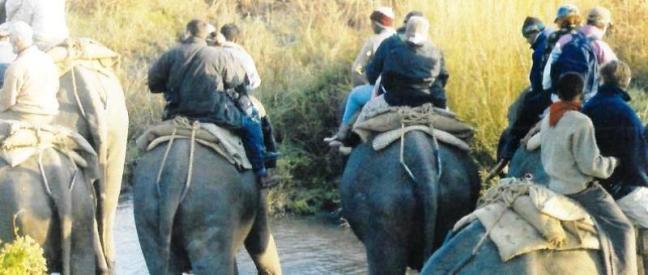
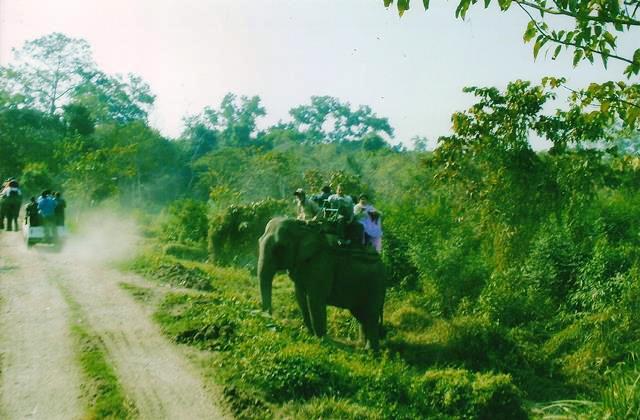
2| JUNGLE WALKS into Manas National Park interiors
Manas National Park is one of the few National Parks in India that allow visitors an option to trek into the park interiors. At Manas, the Jungle walk starts near the Mothanguti Forest Lodge and initially follows the banks of the Manas River, where there is a best chance of spotting several bird species. Later, the route turns from the river to follow an animal trail through dense jungle foliage underneath the high forest canopy where Capped Langur and even the rare Golden Langur may see. The walk is accompanied by forest guards and a naturalist.
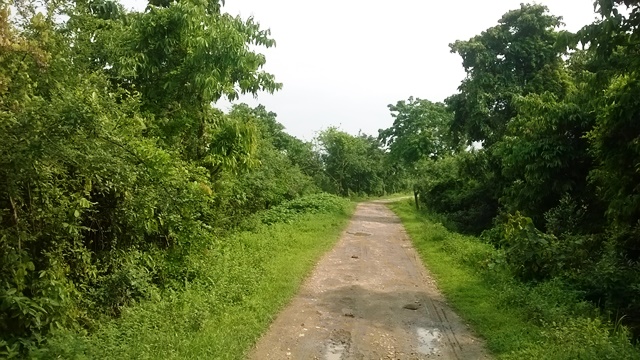
3| River Rafting at Manas National Park
Another repertoire added to the glory of Manas National Park is the availability of the option to spot majestic species via River Rafting. Some of the animals that come out on the banks of the River Manas, such as Wild Buffalo, Deer and Elephant Herds, can be best seen from the safety and serenity of a rubber boat which commences its ride from Mothanguri and ends about 35 kilometers away at Bispani. From Bispani you will be picked up and transferred to your Hotel/Resort via pre-arranged transport. The boatmen are very experienced and your safety is always their first concern.
| Nationality | 01 pax | 02 pax | 03 pax | 04 pax | 05 pax | 06 pax |
| Indian | 8,200/- | 8,300/- | 10,200 | 10,300 | 10,450 | 10,600 |
| Nationality | 01 pax | 02 pax | 03 pax | 04 pax | 05 pax | 06 pax |
| Foreign | 9,400/- | 10,200/- | 12,800/- | 13,600/- | 14,500/- | 15,500/- |
4| Visit to BODO VILLAGES at Manas National Park

The Bodo tribe, indigenous to Assam, have a rich culture of textile, handloom and music. At Manas National Park visitors can choose to visit these local Bodo villages and take a walk around these villages where one can get to see various Bodo women weaving their traditional fabrics and observe life at close quarters.
5| TRIBAL DANCES at Tourist Resorts and Cottages at Manas National Park

The Bodo people inhabiting the area around the Manas National Park have a rich tradition of music and dance. The Bagurumba Dance of the Bodo people is one of the most colorful dance forms of Assam after the Bihu dance and can be observed during your visit to the Manas National Park. The various Hotels and Resorts around the vicinity of the Manas National Park arrange for these tribal dances for their guests upon request and this is a memorable experience to watch. Guests at these resorts can enjoy these traditional dances sitting around a campfire and watch age-old stories of rural life unfold through dance. These performances are a regular feature for residents, particularly for groups here at the Manas National Park.
To book your Jungle Safari in Manas National Park in Assam please tell us:
Resorts, Hotels and Cottages at Manas National Park ~
1| The BANSBARI LODGE at Manas National Park ~

The Bansbari Lodge is situated right near the Entrance of the Manas National Park. This beautiful jungle Resort has the lovely view of lush tea gardens of Manas National Park on one side and the jungles of the Himalayan foothills view on the other side. The 16 large twin-bedded rooms all have attached bathroom and the Lodge is simply but comfortably furnished. The Bansbari Lodge at Manas National Park is an ideal jungle retreat with the concept of sustainable tourism as can be seen from the various decors inside the this resort at Manas National Park which are made up of bamboo and cane and other environment friendly goods. On your arrival at the Bansbari Lodge in Manas National Park you will be welcomed in a true inviting atmosphere. On your arrival here there is a welcoming atmosphere to the Lodge, which includes an attractive dining room and a lobby where you can comfortably relax browsing through the books in the library. Each bedroom has comfortable twin beds, a writing cum dressing table, cane chairs and good cupboard space. The bathrooms are clean and well maintained and have excellent hot and cold showers. There are no television sets inside the rooms as the owners wants you to enjoy the calm and serene jungle atmosphere of the Manas National Park.
The Bansbari Lodge is located at around 176 km from the Guwahati airport and takes 4 hours by road to reach here. The nearest railway station is at Barpeta road which is 20 km away from the Lodge. Various activities into the Manas National Park are arranged by the Bansbari Lodge like Jeep Safari, Elephant Safari, River Rafting, Jungle walks into Manas National Park, Visit to the nearby Bodo villages, Traditional Folk dance performances in the evening, etc. The Bansbari Lodge at Manas National Park has an inhouse restaurant that serves its visitors with lip smacking traditional recipes and also continental dishes.
| Room Type | No of Rooms | Accomodation | Tariff |
| Non AC Double Bedded | 16 | Single/Double | 3,000 |
2| The MUSA JUNGLE RETREAT at Manas National Park ~

Luxury meets Serenity at the MUSA JUNGLE RETREAT at Manas National Park. Under the administration of one of the best Hotel chains in Assam LBS Tourism Private Limited, this luxury resort ensures your comfortable stay at Manas National Park. A sprawling green campus filled with the bounties of Mother Nature makes this one special. An Ethnic Restaurant that serves local recipes and evening Cultural events by the Bonfire will ensure your Wildlife Journey at Manas National Park will be an event you cherish for your lifetime. ‘MUSA’ means Tiger in the local Bodo language. MUSA JUNGLE RETREAT location is one of the best in India for a Jungle Resort. MUSA offers a 24 hour view of the National Park at the North of the property and the guests wake up to the peacock calls and sleep to the sounds of the forest silence, often broken by the roar of a Tiger. The MUSA Jungle Retreat is one of the few properties in the World where one can feel the Wilderness even from his bed.
| Room Type | Accommodation | Tariff (INR) |
| Stripped Panthera | Single | 4,800 |
| Stripped Panthera | Double | 5,200 |
| Grazing Rhino | Single | 7,100 |
| Grazing Rhino | Double | 7,600 |
| Bansbari Villa | Single | 12,000 |
| Bansbari Villa | Double | 12,500 |
| Extra Mattress – INR 800 | ||
3| The SMILING TUSKER ELEPHANT CAMP at Manas National Park ~

Initiated as a project to protect, conserve and spread awareness about the Asiatic Elephants population at Manas National Park, a team of nature enthusiasts started the Smiling Tusker Elephant Camp at Manas National Park in the year 2013. The Smiling Tusker Elephant Camp at Manas National Park runs under the NGO named Anajaree whose motive is to provide a means of employment to the trained elephants of Manas National Park who have over the period of years lost their jobs in the jungle after the ban on timber cutting was imposed. Asiatic Elephants are often killed down by poachers and by villagers as well when they stray out of the jungles and come near the area of the villages. The idea of Smiling Tusker Elephant Camp is also to spread awareness to the villagers no to do so and train the poachers not to hunt down these majestic beasts.
The Smiling Tusker Elephant Camp is located conveniently near the boundary of the core area of the Manas National Park with the beautiful forest reserves of Manas National Park on one side and the tea gardens surrounding the other sides of the Camp. The Smiling Tusker Elephant Camp offers various accommodation options like Cottage Tents, Outdoor Tents and Machan Tents which are all equipped with amenities like running water, western toilets, shower baths, etc. Keeping in mind the idea of nature conservation, the camp relies on harnessing solar power for the camp utilities which is also backed up by a genset. The Smiling Tusker Elephant Camp at Manas National Park also has an inhouse restaurant that serves its guests with hygienic and delicious traditional food options. The camp offers great discounts for student excursions to Manas National Park as well. In addition to offering pleasant accommodation options and hygienic food, the Smiling Tusker Elephant Camp also arranges for various activities inside the Manas National Park like nature trails, village trails, walking with the camp elephants, bathing the elephants, feeding he elephants, elephant safari, campfire, various sports activities, student interactions, traditional dance programs, etc.
| Room Type | Accommodation | Tariff |
| Non AC Tent with attached Toilet on AP Meal Plan | Single/Double | 3,600 |
4| The MANAS MAOZINGENDRI ECOTOURISM SOCIETY at Manas National Park ~

Perhaps the best example of a community based self sustainable conservation project is the Manas Maozigendri Ecotourism society. If any visitor to Manas National Park would want to understand how a successful conservation story happened at Manas then he should choose to stay here at the Jungle Camps of the Manas Maozigendri Ecotourism Society. From a time when unscrupulous activities against nature like heavy logging and poaching were very much rampant inside the reserves of Manas National Park in the late 1990’s, Manas Maozigendri Ecotourism Society is an example of how true hard work and dedication has helped the like minded thoughts of a handful of people to convert a National Park in danger to it being awarded as one of the best National Parks of India as on today.
In short, during the late 1990’s and early 2000’s the area around Manas National Park was under constant threat of its resources being depleted because of heavy logging and poaching of animals under the Bodo Liberation Tigers who were an armed infiltration group who demanded a separate State as they thought they were being suppressed by the State Government. The situation was so drastic that Manas National Park was declared as a UNESCO World Heritage Site in danger. To bring this menace to an end the Manas Maozigendri Ecotourism Society was born in 2003 with the sole objective of saving Manas National Park and to bring it back to its previous glory. They went about the local villages educating people of the ill effects of poaching and how this is a short lived survival idea and instead how they could bring in a way to create a means of livelihood for longer periods. Their efforts paid off and as many as 50 poachers gave up their arms and went ahead conserving the resources of Manas National Park.
Over the years, today Manas Maozigendri Ecotourism Society runs a fully fledged Jungle Camp that has four traditional cottages and an additional 2 nos. Guest Houses in a nearby village along with a few homestays here too. These combined setups are decent enough to accomodate over 50 guests to Manas National Park at any time during the year. Along with these camps inside the core area of Manas National Park, the Manas Maozigendri Ecotourism Society has also setup variou self help groups that train villagers in handlooms, handicrafts, cultural music and dances, etc. The MMES project engages at present a pool of 50 people as staff who do various work in the camp as service, housekeeping, gardening, maintenance, etc. and cater to the various needs of the visitors to the Jungle Camp. These members also go out for patrolling inside the reserves of Manas National Park and keep a check on poaching activities. If being part of the successful conservation story of Manas National Park is your interest then a stay at the Jungle Camp of MMES is a must for you.
| Room Type | No of Rooms | Accomodation | Tariff |
| Non AC Double Bedded | 3 | Single/Double | 3,000 |
5| The FLORICAN JUNGLE COTTAGE at Manas National Park ~

A place to be if you want to step out of an environment powered by Air-Conditioning and artificial lighting. The Florican Jungle Cottage creates an ideal Eco environment for its visitors with much less of the modern World. Without electricity (not necessary during the Winter season) the Florican Cottage offers deluxe one bedroom cottages with attached bathroom and full dining facilities at Bansbari gate in Manas National Park.
Florican Cottages at Manas National Park is one of the most comfortable properties to stay around the area of the Manas National Park. The Florican Cottage is located right at the heart of the core area of Manas National Park and offers international standards when it comes to a pleasant stay experience in a wildlife environment. In addition to providing luxurious stay options under standard and deluxe categories here at the best possible budget rates without compromising on standards, the Florican Cottage offers delicious food options to all its guests during their stay at Manas National Park. The Florican Cottage offers various stay packages for adventure tourists and student excursions at Manas National Park. From the cottages, visitors can go for various activities into the interiors of Manas National Park like on Jeep Safari, Elephant Safari, River Rafting, Jungle walks, etc. During the evenings, a Bonfire is lit and cultural dances of the local Bodo tribes of Assam can also be arranged upon your request.
| Room Type | No of Rooms | Accomodation | Tariff |
| Double Bedded Non AC | 6 | Single/Double | 2,100 |
| Tent Non AC | 1 | Single/Double | 2,500 |
| Cottage Non AC | 2 | Single/Double | 3,300 |
6| The BIRINA ECO CAMP at Manas National Park ~

The area of the Manas National Park is surrounded by the lush and green heritage tea gardens of Assam. These tea gardens were under the operations of the legacy of the British Raj and has several British style heritage bungalows attached to the tea gardens. The Birina Eco Camp at Manas National Park is one such place which was once a tea garden bungalow and has now been converted to an Eco Resort setup that hosts visitors to Manas National Park near the Bansbari Safari range. At present the Birina Eco Camp has a setup that consists of a heritage Tea Bungalow, a few eco friendly cottages and tented accommodations too. The cottage are thatched roof here giving it a rustic traditional Assamese look. All these accommodation options here have modern amenities and are furnished with Bamboo and Cane furnishings.
The area around the Birina Eco Camp at Manas National Park has a sprawling campus that has inside a beautiful garden, play area for children and an open space to host bonfires, cultural performances and an open dining experience. The rooms are quite spacious marked with 24 hours hot and cold running water, clean linens and various other facilities. A power generator is at disposal is necessary. The Birina Eco Camp also has an inhouse restaurant that churns out some real delicious Assamese style recipes. The staff of the camp are friendly, courteous and well trained and cater to the smallest requirements for the visitors here.
| Room Type | No of Rooms | Accommodation | Tariff |
| Double Bedded Non AC | 1 | Single/Double | 1,900 |
| Triple Bedded Non AC | 1 | Single/Double | 2,300 |
| Double Bedded Cottage Non AC | 1 | Single/Double | 2,300 |
| Four Bedded Non AC Tent | 2 | Single/Double | 2,900 |
| Four Bedded Non AC Cottage | 1 | Single/Double | 3,300 |
7| THE SIKHRI RESORT at Manas National Park

The Sikhri Resort is located in the heart of the Manas National Park and is at a distance of just 2.5 km from the main entrance of the National Park gate at the Baraguri village. A beautiful place to unwind after your day of safari inside the interiors of Manas National Park, the Sikhri resort is situated amidst the majestic tea gardens and the lush green paddy fields of Manas National Park. The backdrop view is the scenic mountains of the Eastern Himalayas. During your stay here you can also enjoy the scenic view of the river that flows alongside the resort. Just relax during your stay here and while not on a safari tour inside Manas National park simply grab a book and unwind in the wonderful atmosphere of the UNESCO World Heritage Site of Manas National Park.
The Sikhri Resort is an Eco Friendly resort that has made use of bamboo for construction of the accomodation options here. here are three elegantly designed bamboo rooms that are furnished with wooden amenities and attached toilets and bath facilities. There is also an open wooden floored area that has options of statin gin tenets here. The Sikhri Resort at Manas National Park offers various amenities like a travel desk and reception, doctor on call conference room, evening bonfire, cultural dance performances, etc. The inhouse restaurant churns out some real ethnic assamese delights of the likes of tangy fish curry, meat recipes, smoked meat, assamese thali, duck meat curry, pickles, aloo pitika, khar, etc. A cup of Assam tea is a must to be had here at Sikhri resort at Manas National Park to rejuvenate our mind and body.
| Room Type | No of Rooms | Accomodation | Tariff |
| Non AC 4 Bedded | 3 | Double | 6,000 |
| Non AC Double Bedded | 3 | Double | 3,600 |
| Non AC Single Bedded | 4 | Single | 2,300 |
8| The CAMP BUFFALO RETREAT at Manas National Park ~

Located at the Bansbari range of Manas National Park, the Camp Buffalo Retreat is another ideal stay option amidst nature in an open pollution free environment nestled far away from the hustle and bustle of a busy city life and this is the perfect place to spend your time in peace amidst the lap of mother nature. The Camp Buffalo Retreat is an ideal adventure and nature camp that is located very close to the Manas river and the soulful sound of the river waters along with the chirping of birds gives its visitors an ideal experience of camping near the beautiful jungles of Manas National Park and helps rejuvenate your mind, body and soul. There is an inhouse restaurant that serves authentic traditional home cooked Assamese cuisine that is simple yet flavorful. While at the Camp Buffalo Retreat, visitors should try their tangy fish curry, the local chicken recipes and various other dishes cooked with organic vegetables and local ferns that are a real delight. Various activities organized at the Camp Buffalo Retreat at Manas National Park are Jeep Safaris, Elephant Safaris, River Rafting, Nature walks, Bonfires, etc.
The Accommodation options offered at the Camp Buffalo Retreat at Manas National Park are luxury Jungle Tents that have attache concrete toilet and bath for the utmost comfort of their visitors. Each luxury tent has two double beds and one single bed and beautifully handcrafted interiors along with two reclining chairs accompanying each tent. They also offer accomodations in dome tents that are put up in open area withing their campus premises.
9| The MANAS MOTEL TOURIST LODGE at Manas National Park ~

Your home at the Manas National Park. The Manas Motel Tourist Lodge is run by the Manas Motel Eco-Society that offers you a typical homely environment with home cooked food. Located near the entrance of the Manas National Park this is a preferred budget accommodation for travelers to Manas.
| Room Type | No of Rooms | Accomodation | Tariff |
| Non AC Double Bedded | 3 | Single/Double | 2,000 |
To book your Accommodation in Manas National Park in Assam please tell us:
Additional Details about Manas National Park ~
The Manas National Park in the State of Assam in India is a UNESCO World Heritage Site (1985) famous for its population of the Endangered Indian One Horned Rhinoceros species, Indian Tiger, Asiatic Wild Water Buffalo, Indian Elephants, Golden Langur and the Pygmy Hog. Contiguous to the Royal Manas National Park in Bhutan, Manas is also a project Tiger Reserve (1973), an Elephant Reserve and a Biosphere Reserve (1989).
Manas National Park is located at the foothills of the towering Eastern Himalayas and is perhaps one among the most beautiful national Parks in India. Situated by the banks of River Manas, Manas National Park shares an International border with the Kingdom of Bhutan. Manas National Park is bordered on its north by the Royal Manas National Park in Bhutan, on the south by the North Kamrup district and the east and west borders are reserve forests. Manas National Park is located across six districts of the State of Assam i.e. Kokrajhar, Bongaigaon, Barpeta, Malaria, Kamrup and Darrang. Manas was declared as a National Park in 1990. It is believed that the name Manas is derived from the Hindu snake Goddess ‘Manasa’ and also from river Manas that flows across the Manas National Park.
Manas National Park falls under six districts of the State of Assam with the major ones being Chirang and Baksa. Along with River Manas and its tributaries Bholaduba and Beki, five other small rivers to flow across the area of Manas National Park. The entire area of Manas National Park is lying on wide and low lying alluvial terrace which is made up of limestone and sandstone. However, towards the south of the Manas National Park, grasslands with deep deposits of alluvial soil is found. The Manas National Park is not only known for its rich biodiversity but also for the majestic landscapes surrounding it. The majestic forests of Manas National Park is sure to leave any visitors to Manas spellbound. The lush Tea Gardens of Assam surround the area of the Manas National Park and the smell of fresh tea leaves is sure to get you rejuvenated in the mornings. In addition to being home to the population of the highly endangered Indian One Horned Rhinoceros, Manas National Park is home to India’s second largest tiger population.
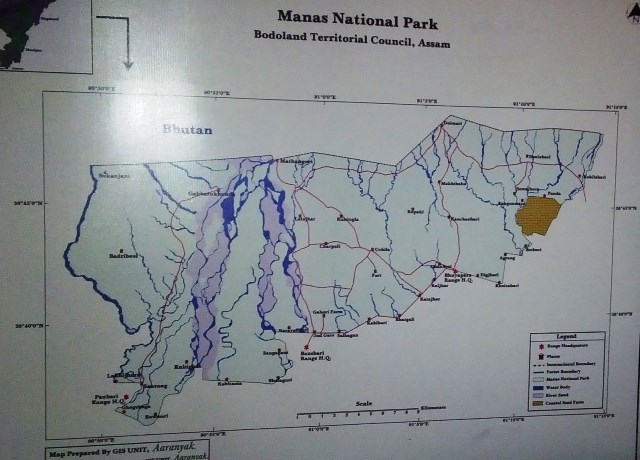
Manas National Park is a UNESCO World Heritage Site and is a constituent of the Eastern Himalayan Biodiversity region and is one of the two biodiversity hotspots in India. Along with bearing the tag of the UNESCO World Heritage Site, Manas National Park is also a Project Tiger Reserve, a Biosphere Reserve, an Elephant Reserve as well as a Biosphere Reserve. Manas National Park is not only known for its rich biodiversity, but also for its unadulterated natural beauty and landscapes that are nestled with forested hills, alluvial grasslands and tropical evergreen forests. Being home to the second largest tiger population in India, Manas National Park harbours the maximum number of endangered species from India as listed in the IUCN Red Book.
Considered to be one among the most important conservation areas in the vicinity of the Himalayan Biodiversity Hotspots, the Manas National Park in Assam is a UNESCO World Heritage site that is renowned across the World as an important conservation area of wildlife. With a widespread and diverse fauna supported with a wide variety of habitat, the Manas National Park is considered as the richest among the wildlife areas in India and Manas also is home to around 22 endangered mammal species of India. An Important Bird Area falling under the Royal Society for protection of birds, Manas National Park is also home to the largest available population of the endangered Pygmy Hog with it also being the only transboundary protected area of the State.
To narrate a brief history of Manas National Park, earlier the area of Manas was used as a hunting area by the Royal family of Cooch Behar and the King of Gauripur. The name ‘Manas’ is derived from the Hindu deity viz. the Snake Goddess ‘Manasa’ and is also shared with Manas river that flows across the National Park.
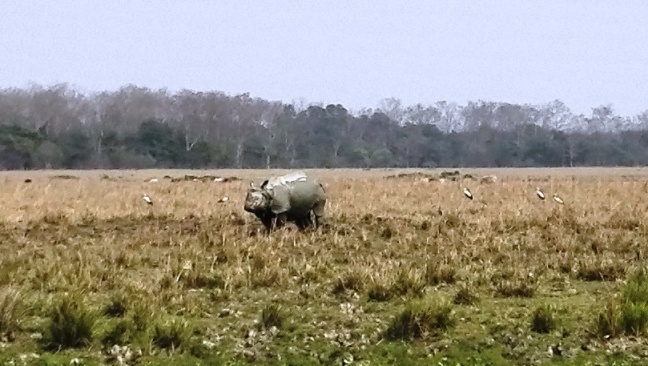
Location and How to Reach Manas National Park:
Manas National Park is located at a distance of approximately 176 kilometers from the city of Guwahati in Assam (4 hours by road). The area of Manas falls under five districts of the State of Assam i.e. Kokrajhar, Chirang, Baksa, Udalguri, and Darrang.
Manas National Park is indeed breathtakingly beautiful situated by the banks of the River Manas (a tributary of the mighty River Brahmaputra). Bounded by the Himalayan foothills, the dense jungle forest alternates with grasslands, Savannah woodland and semi-evergreen forests, providing a rich wilderness for a great variety of wildlife, including many endangered species. The Project Tiger Reserve extends over an area of 2837 square kilometers with a core area of 519 square kilometers.
Occupying an area of around 500 sq. km. which comprises of the core area of Manas National Park, the Manas Tiger Reserve is having a total area of around 2900 sq. km. and it stretches along the rivers Sankosh and Dhansiri and is also contiguous to the Royal Manas National Park in Bhutan. Being a key conservation landscape, the Manas National Park is located at the junction of the Indo-Gangetic, Indo-Malayan and Indo-Bhutan realms. Manas National Park is situated in the eastern dwr and terai area of the Eastern Himalayas which are mostly flat and well drained areas with a gentle slope towards south however getting water logged during rains. The River Manas flowing across the Manas National Park splits up into two namely Manas and Beki. Manas is a fast flowing river enters the plains of Manas National Park gradually losing its speed and gradually depositing boulders, sand, silt and debris in the park leading to alluvial deposits inside the area of the Manas National Park.
The best option to reach Manas National Park is to arrive at Guwahati Airport/Railway Station and drive to the National Park. We arrange your transport from the Airport to the National Park with an experienced local who will guide you with the important facts of the region during the journey.
Climate and Best Time to visit Manas National Park:
Manas National Park witness three seasons: Summer, Monsoon and Winter. The months of November thru April witness winter with favorable temperature conditions to enjoy your Jeep/Elephant Safari into the park interiors. The months of May and June is Summer season with slightly higher temperatures noted. July through September are the monsoon seasons and the park gets submerged owning to the heavy downpour.
Manas National Park remains open for viewing for tourists around the year. The best time to visit the Manas National Park is during the winter thru the months of October and May.
The climate of Manas National Park is moist tropical with an annual rainfall between 3000 mm. to 4000 mm. The climate can be divided into four distinct seasons based on the variation in the rainfall, temperature and winds which are as follows:
Winter (December-February): The winter season at Manas National Park is characterized by cool weather and fog. The average temperature 20 degree celsius. January is the coldest month around here. Average total rainfall at Manas National Park is 114 mm with relative humidity of 77%.
Pre-Monsoon (March-May): Manas National Park the pre-monsoon is transitional period between relatively dry winter and hot summer and is characterized by a rapid rise in temperature. As the season advances in Manas National Park, the amount of frequency of rainfall increases due to frequent thunderstorms with hail storms. Average temperature and humidity in this season are 23 degree celsius.
Monsoon (June-September): The monsoons in Manas National Park is characterized major rainy season of the year. The average monthly rainfall is 2860 mm. The average temperature during this season is around 28 degree celsius at Manas National Park.
Retreating Monsoon (October-November): At Manas National Park, towards the end of September the monsoon weakens with an abrupt retreat followed by fair weather. With the advancing of the season the temperature falls and moving mist and fog appears. With an average temperature of 27 degree celsius, Manas National Park during this time records an average monthly rainfall of 1400 mm.
Manas National Park in addition to being a favored wildlife destination for tourists from across the world is also now becoming a hotspot for community based ecotourism where visitors get to experience a way of living and understanding the lifestyles and cultures of the people around the area and get to experience a form of tourism that helps in the upliftment of the living standards to the people of the area. At Manas National Park, in addition to experiencing the wildlife safaris visitors can also get a rustic experience of a traditional festival in the nearby local Bodo village, witness their way of life and see their age old traditions, beliefs and culture, take a tour of the village to witness rural life, get hands on experience on weaving of exquisite handicrafts and handlooms, witness traditional dances like the ‘Bagurumba’ of the bodo people, witness brewing of traditional rice beer, eat traditional local cuisine, go and see the agricultural fields, take a tea garden tour and visit the nearby tea factory and perform a host of other traditional activities.
Spring is a beautiful season in the forest reserves of Manas National Park. It is a time when the chilly winter winds recede, the temperatures become favorable and the blossoming of fresh leaves and flowers. A new life springs into the flora and fauna of species of Manas National Park during this time and in order to celebrate this vibrant life here an annual ‘Spring Festival’ is organized every year in the month of April at Bansbari area of Manas National Park. The Manas Spring Festival is organized by Swankar Mithinga Onsai Afat in association with Indian Weavers’ Alliance, an initiative of Food Sutra By Mitali Dutta and the Park Authority of Manas National Park. The Manas Spring Festival is one of the best times to visit Manas National Park as it offers the traditional cultures of the Bodo tribes of Manas along with the jungle wilderness experience. Nt only do visitors get to sight the varied flora and fauna of Manas National Park but also get to experience the life of the local people by visiting their villages, tasting local cuisine, visit a farmer’s market, handlooms and handicraft market and also get a chance to cook traditional food with the local people.
Flora, Fauna and Avi-Fauna at Manas National Park:
Flora ~ The vegetation that covers most of the park is of mixed deciduous variety. The forest is interspersed with small grassy glades where large of deer species can be seen grazing. The topography of the park is mainly small meadows among thickly forested foothills with many rivulets, streams and natural drainage channels. In Manas National Park, the grasslands cover about 50% of the National Park area. The vegetation of Manas National Park is classified as the “Eastern wet alluvial grassland”. In broader scale these grassland can be categorized as Phragmites-Saccharum-Imperta Type. Apart from the grasslands, rest of Manas National Park forest represented by Sub-Himalayan high alluvial, Semi evergreen, Eastern Himalayan moist mixed deciduous and Assam semi evergreen forests. There is also a considerable variety of aquatic flora alongside the river banks and pools of Manas National Park. Semi-evergreen is considered the climatic climax forest in the Manas National Park. So far in Manas National Park around 500 species have been identified.
The park is mainly drained by the river Manas which also forms the International boundary between Bhutan and India. In the lower reaches there are smooth sandy stretches with clumps of trees growing in and around them. Dominant flora of Manas National Park are Aphanamixis polystachya, Anthocephalus chinensis, Syzygium cumini, Syzygium formosum, Syzygium oblatum, Bauhinia purpurea, Mallotus philippensis, Cinnamomum tamala, Actinodaphne obvata, Bombax ceiba, Sterculia villosa, Dillenia indica, Dillenia pentagyna, Careya arborea, Lagerstroemia parviflora, Lagerstroemia speciosa, Terminalia bellirica, Terminalia chebula, Trewia polycarpa, Gmelina arborea, Oroxylum indicum, Imperata cylindrica, Saccharum naranga, Phragmites karka, Arundo donax, Dillenia pentagyna, Phyllanthus emblica, Bombax ceiba etc.
Fauna ~ Manas National Park is famous for its population of the Indian One Horned Rhinoceros. In addition, three unique residents of Manas are the rare Pygmy Hog, the Hispid Hare and the Golden Langur. The Park is a haven for more than 20 highly endangered species. The diverse animal population of Manas National Park includes some fierce and potentially aggressive creatures such as Tigers, Elephants, Golden Cat, Fishing Cat, Wild Buffaloes, Leopards, Clouded Leopards, Civet Cat, Wild Dog, Indian Fox, Gaur and Himalayan Black Bear. Less assertive creatures such as many varieties of Deer, Capped Langurs, Assamese Macaques, Slow Loris and Hollock Gibbons have also made Manas National Park their home.
Avi-fauna ~ Due to its climatic conditions and topography, Manas National Park is home to many bird species, both resident and migratory. Amongst the bird species found at Manas National Park are Bengal Florican, Giant Hornbill, Jungle Fowls, Bulbul, Brahminy Duck, Khaleej Pheasant, Egret, Pelican, Fishing Eagle, Serpent Eagle, Falcon, Scarlet, Bee-Eater, Kingfisher, Magpie Robin, Pied Hornbill, Gray Hornbill, Merganser, Harrier, Osprey, Heron, Buzzard, Lapwing, Plover, Sandpiper, Snipe, River Tern, Woodpecker, Warbler, Chat, Thrush, Tit.
Surroundings and Stay Options at Manas National Park:
Manas National Park is located in the lower range of the State of Assam. Assam is well known as the ‘Land of Red Rivers and Blue Hills’ because of its breathtaking nature and this description is quite evident once you are at the Manas National Park. Manas National Park has a total area of 519 square kilometers and almost 2/3rd of this is under forest cover. The National Park is located in the midst of the lush Tea Gardens of Assam and the fragrance of fresh tea leaves being plucked will instantly refresh you after your day of Jungle Safari at Manas National Park.
Well known Resorts, Hotels and Guest Houses are to be found across the four ranges of the Manas National Park that extend a warm hospitality and leave no stone unturned to make your stay here comfortable and memorable.
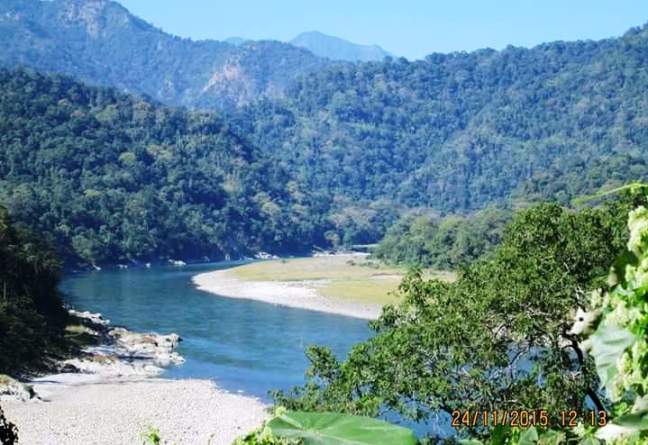

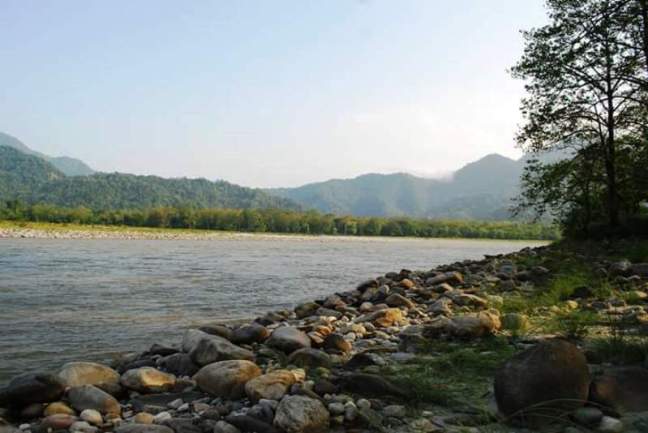
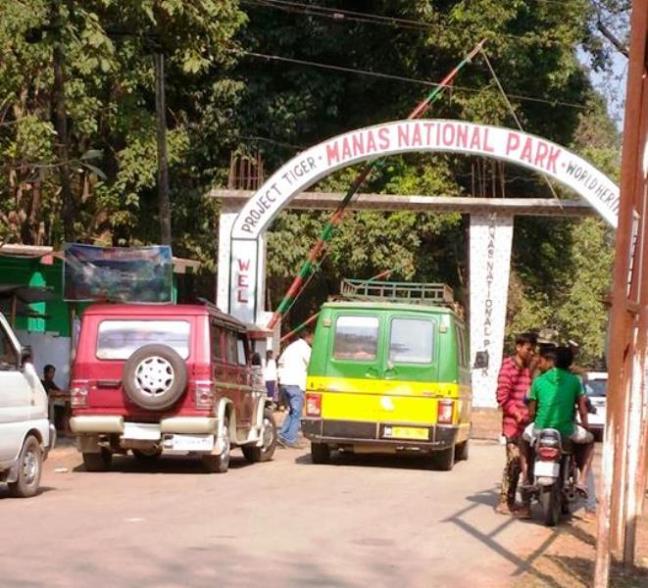
Tribes and Ecotourism at Manas National Park ~
India’s North East is home to over 200 Tribes and each tribe have their own distinct Culture, Religious practices, Language and Food Habits. The Manas National Park is inhabited by arguably the oldest Tribes of Assam ~ the ‘Bodo Tribes’. The Bodo Tribe is an ethnic group of the Brahmaputra valley in Northeast India and these tribal people use the term ‘Bodosa’ (which is pronounced as Borosa meaning son of Bodo) to describe themselves.
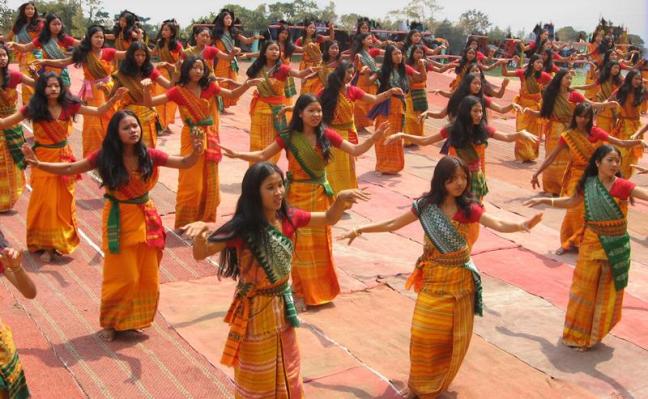
It is believed that very early on, the Bodos had introduced rice cultivation, tea plantation, pig and poultry farming, and silkworm rearing in North East India. Rice is a staple food of the Bodos and is often accompanied by a non-vegetarian dish such as fish or pork. Weaving is another integral part of the Bodo culture. Many families rear their own silkworms, the cocoons of which are then spun into silk. Bodo girls learn to weave from a young age, and no Bodo courtyard is complete without a loom. Most women weave their own Dokhonas (the traditional dress of the Bodo women) and shawls. Almost every household owns a loom and handing over a shawl or a ‘dokhona’ to a visitor is an honour. The Bodos are also expert craftsmen in bamboo products.
- Manas Maozigendri Ecotourism Society at Manas National Park:
The Manas Maozigendri Jungle camp is a small setup with four cottages and a dining cum commons area in ethnic style architecture. In the nearby village two guesthouses can accommodate 20 guests and for those who prefer immediate insight into a Bodo household home stay facilities are available.
The project currently engages a pool of 31 local people as staff (service, housekeeping, gardening, and maintenance) and guides. Whenever tourists visit, the members of this staff pool independently manage their schedule according to their vacancy. This extended staff pool is an excellent model to guarantee best service quality to the customers’ 24/7.The local cuisine uses rice and fresh vegetables. Pork, chicken and fish are common, as the Bodos traditionally are non-vegetarians. The favorite drink of the Bodo’s is a rice-wine named ‘Zu Mai’.
Along with the Camp various self-help groups like hand-loom and cultural music and dance groups have been initiated.
The conservation volunteers of the Manas-Maozigendri Ecotourism Society (MMES) daily go out for patrolling in the National Park and since poaching activities and the extraction of timber have decreased significantly. The entry points to the National Park are permanently guarded, and park management activities like controlled burning of grassland habitats are carried out.
Besides the local Bodo people, many affiliated with the Manas-Maozigendri Ecotourism Society, the field director’s office of Manas Tiger reserve, the Bodoland Territorial Council, other Conservation NGOs, and few stakeholders from the travel trade are cooperation partners of the project.
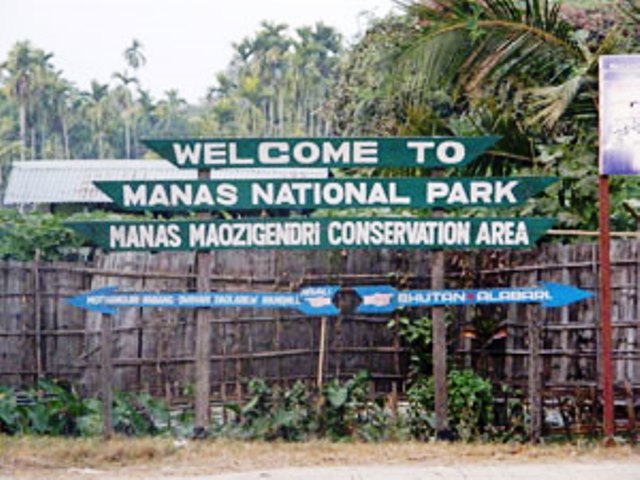
Jungle Safari Options at Manas National Park ~
1| JEEP SAFARI into Manas National Park interiors

An all terrain 4WD is one of the best options of exploring the Flora, Fauna and Avi-fauna at the Manas National Park in Assam. These all terrain vehicles take you into the Wilderness of the dense forests of Manas National Park. Jeep drive rides are offered on a 60 or 90 kilometer drive basis. The shorter route through grassland and forests is from Lotajhar-Mathanguri-Gyati-Uchila-Kuribheel-Burabari and return; the 90 kilometer Itinerary is of special interest to Birdwatchers and it takes you inside the area around the village of Koklabari and then through the jungle to Alabari an Namlang. To facilitate bird watching easier, there are a number of watchtowers built by the forest department on both these routes.
| Jeep Safari rates in INR (Per head) Indian Nationality | ||
| Half Day Safari (INR) | Full Day Safari (INR) | |
| 1 person | 3400 | 6300 |
| 2 person | 1800 | 3300 |
| 3 person | 1300 | 2270 |
| 4 person | 1100 | 1780 |
| 5 person | 860 | 1460 |
| Jeep Safari rates in INR (Per head) Foreign Nationality | ||
| Half Day Safari (INR) | Full Day Safari (INR) | |
| 1 person | 3900 | 7000 |
| 2 person | 2450 | 4000 |
| 3 person | 2000 | 3000 |
| 4 person | 1750 | 2500 |
2| ELEPHANT SAFARI into Manas National Park interiors

The view of the dense reserves of the Manas National Park looks magnificent on-board the ride of the Kings – ‘ELEPHANT SAFARI’. The Manas National Park spans as a huge and varied area and exploring this on an Elephant Safari is a once in a lifetime experience. Elephant Safari start as early as 5 AM in the mornings which serves as an ideal time to spot Animal species in the Manas National Park. Sitting abode the King of the animal kingdom you can care less in case you are able to spot Tigers at Manas National Park. This Safari option guarantees your luck to sight the Majestic One Horned Rhinoceros species at Manas. However, the Elephant Safari is subject to availability on the day as first priority is always given to Jungle patrolling by the park authorities.
| Safari Rates in INR | Indian (Price Person) | Foreigner (Price Person) |
| Elephant (Per head) Adult /Child | 1,150/- | 2,200/- |
3| River Rafting Manas National Park

Another repertoire added to the glory of Manas National Park is the availability of the option to spot majestic species via River Rafting. Some of the animals that come out on the banks of the River Manas, such as Wild Buffalo, Deer and Elephant Herds, can be best seen from the safety and serenity of a rubber boat which commences its ride from Mothanguri and ends about 35 kilometers away at Bispani. From Bispani you will be picked up and transferred to your Hotel/Resort via pre-arranged transport. The boatmen are very experienced and your safety is always their first concern.
| Nationality | 01 pax | 02 pax | 03 pax | 04 pax | 05 pax | 06 pax |
| Indian | 8,200/- | 8,300/- | 10,200 | 10,300 | 10,450 | 10,600 |
| Nationality | 01 pax | 02 pax | 03 pax | 04 pax | 05 pax | 06 pax |
| Foreign | 9,400/- | 10,200/- | 12,800/- | 13,600/- | 14,500/- | 15,500/- |
Sample Itinerary Option for your visit to Manas National Park ~
Day 1 ~ Guwahati – Manas National Park
Arrive at Guwahati Airport. On arrival you will be received by our representative at the airport offering a warm welcome in traditional Assamese style. From the Airport drive to the to the Manas National Park. Enroute visit one of the longest bridges of North East India on the mighty Brahmaputra ‘the Saraighat Setu’. Check into Jungle Resort at Manas National Park . Evening free to take a walk along the tea gardens nearby your Resort.
Night Stay: Jungle Resort at Manas National Park
Meals Included: NA
Day 2 ~ Manas National Park
Early morning take an adventurous Elephant Safari into the Manas National Park and spot a variety of Wildlife to experience Wildlife Wilderness at Manas. Afternoon visit the Bodo tribal villages and learn about the traditional practices and the rich heritage of the arguably the oldest tribes of Assam. Enjoy Bonfire and Cultural dances in the evening (on request only).
Night Stay: Jungle Resort at Manas National Park
Meals Included: Breakfast
Day 3 ~ Manas National Park – Guwahati
Today you will go deep into the forests of Manas National Park and enjoy a day of Jeep Safari at Manas. This ride will take you deeper into the jungles of Manas to spot exotic species of birds, flora and fauna. Later we will depart to Guwahati.
Night Stay: Comfortable Hotel at Guwahati
Meals Included: Breakfast
Day 4 ~ Kamakhya Temple – Depart
Early morning visit the holy Kamakhya Temple at Guwahati. After breakfast you will depart to Guwahati Airport for your onward destination. Trip Ends. Bid Adieu!
Meals Included: Breakfast
Dominant Fauna of Manas National Park ~
1| Indian One Horned Rhinoceros at Manas National Park:

The Endangered Indian One Horned Rhinoceros species was introduced in the Manas National Park as a part of its conservation initiative. The initiative proved to be successful and now Manas boasts of a sizable population of the Indian One Horned Rhinoceros.
The Indian Rhinoceros of Manas National Park is a majestic beast weighing up to 4000 kilograms and has a thick grey-brown skin and a prized horn. This horn is present in both the male and female species of the Indian Rhinoceros and is made up of pure keratin. The rhino horn records a length of up to 25 cm. In Asia, the Indian Rhinoceros is second in size only to the mammoth Asian Elephant species. Second largest behind the White Rhinoceros, a male rhino on an average weighs around 2,200 kilos while a female rhino around 1,600 kilos.
Since many years, Indian One Horned Rhinos have been widely slaughtered for their horn, a prized ingredient in traditional Asian medicines. Destruction of their habitat over the years, has brought the rhinos to the brink of extinction. These animals are among the world’s’ most endangered species. By the turn of the century, this species had vanished from much of its range, and today only about 2500 survive in India and Nepal. Throughout their range, their habitat continues to dwindle fast due to conversion of grassland habitats into agricultural fields and other human pressures. The threat of poaching continues to be ever-present.

Effective conservation has ensured that the Indian Rhinoceros species have been brought back to revival from a brink of extinction with efforts from all local governments and International foundations. Today, the number of Indian Rhinoceros present across various National Parks and Wildlife Sanctuaries of India are noticeable and their numbers are continuing to rise. Their numbers across as per a survey in 2006 are as follows ~
- in Kaziranga National Park: 2,043
- in Pobitora Wildlife Sanctuary: 102
- in Orang National Park: 94
- in Gorumara: 27
- in Dudhwa National Park: 21
- in Manas National Park: 35
- in Katarniaghat Wildlife Sanctuary: 2
The Indian One Horned Rhinoceros is an active grazer that travels across the deep forest reserves in established, tunnel-like paths through its tall-grass habitat. It grasps tall grasses with its prehensile (gripping) lip. In addition to grass, rhinos eat fruit, leaves, and sometimes farm crops. They are often around water and sometimes consume aquatic plants. These animals forage in the cooler temps of morning and afternoon to avoid exerting themselves in the debilitating midday heat. When the sun is high, they often wallow or submerge themselves in water.

Known to have excellent sense of hearing and smell but relatively poor eyesight, the Indian Rhinoceros species are usually solitary. Active during early mornings, late afternoons and night, the Indian Rhinoceros are primarily grazers feeding on mostly grasses and also leaves, fruits, shrubs and floating aquatic plants.
There was a time when the entire area of the forest reserves of Manas National Park was alive with the presence of over 100 rhinoceros prior to 1989. But due to the insurgency and poaching activities in the late 1990’s the population of this majestic beast was reduced to nil and the need for the protection of the habitat of the rhinos at Manas National Park was initiated in 2003 with the establishment of the Manas Maozigendri Ecotourism society. In conjugation, the Government of Assam along with the International Rhino Foundation (IRF) launched the Indian Rhino Vision (2020) and through this the population of the Rhinoceros around Assam was set to have a target of 3000 by the year 2020. A translocation project was initiated to transfer two rhinos from the Pobitora Wildlife Sanctuary to Manas National Park on 11th April, 2008. It was in the morning of 11th April, 2008 that the best veterinarians of Assam and members of the authority of Manas National Park gathered at Pobitora Wildlife Sanctuary and were successfully able to tranquilize two adult male rhinos and load them on a transport vehicle and transfer them to Manas National Park. These two adult male rhinos were later released at the Buraburijhar area under the Bansbari range of Manas National Park on the wee hours of the morning on April 12th, 2008. This was a proud moment for the authorities of Manas National park and the local people who were elated to have the Rhino population back in the ranges of Manas National Park and work towards the vision of Rhino 2020. Continuous monitoring began if the Rhinos here and regular patrolling were undertaken for the safeguarding of the rhino species here. Continuous support and efforts that included relocation and rehabilitation of these rhino species have now raised the population of Indian One Horned Rhinoceros at Manas National Park to a healthy number of 35 at present.

2| Indian Tigers at Manas National Park:

The Bengal tiger, also called the Royal Bengal tiger, is the most numerous tiger subspecies. It is the national animal of India. By 2011, the total population was estimated at fewer than 2,500 individuals with a decreasing trend. Since 2010, it has been classified as endangered by the IUCN.
As of 2010, Bengal tiger populations in India have been estimated at 1,706–1,909. As of 2014, they had reputedly increased to an estimated 2,226 individuals.
Manas National Park has been been declared as a Project Tiger Reserve and there is a sizable population of the Royal Bengal Tiger in the Park. Other National Parks of Assam containing habitat of this species are the Kaziranga National Park and the Nameri National Park, both declared as Project Tiger Reserves.
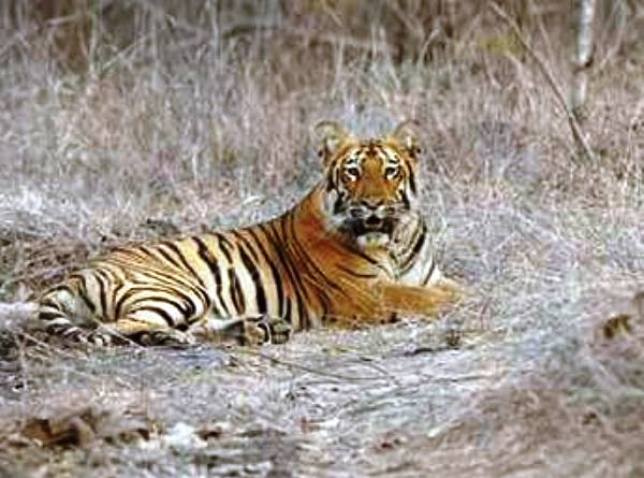
Tigers of the Manas National Park are primary carnivores. They prefer hunting large ungulates such as chital, sambar, gaur, and to a lesser extent also barasingha, water buffalo, nilgai, serow and takin. Among the medium-sized prey species they frequently kill wild boar, and occasionally hog deer, muntjac and grey langur found at the Manas National Park. Small prey species such as porcupines, hares and peafowl form a very small part in their diet. Because of the encroachment of humans into their habitat, they also prey on domestic livestock.
3| Asiatic Elephants at Manas National Park:

Manas National Park has a huge population of Indian Elephants. The Indian elephant (Elephas maximus indicus) is one of three recognized subspecies of the Asian elephant and native to mainland Asia. Since 1986, these Indian Elephant species have been listed as Endangered by IUCN as their population has declined by at least 50% over the last 60 years. These majestic beasts – the Indian Elephants are constantly threatened by habitat loss and degradation.
The Indian Elephants inhabit primarily the open grasslands, evergreen and semi-evergreen forests of mainland Asia viz. India, Nepal, Bhutan, Myanmar, Thailand, China, etc. Smaller in size than the African Elephants, the Indian Elephants species weigh between 2,000 to 5,000 kilograms. They have a grey-brown skin and easily identifiable tusks.
Known to be megaherbivores, the Indian Elephants graze on tall grasses and also on bark of white thorn tree and other flowering plants and consume fruits of wood apple, tamarind and date plants. The dense jungles and forest reserve of Manas National Park make it an ideal habitat for the Indian Elephants as being megaherbivores, these Elephants consume up to 150 kg of plant matter per day. They are generalist feeders, and both grazers and browsers. In India, Elephants are recorded to feed on 112 different plant species, most commonly of the order Malvales, and the legume, palm, sedge and true grass families. They graze on the tall grasses, but the portion consumed varies with season.
4| Primates of Manas National Park:

The Manas National Park is a haven for Wildlife Enthusiasts. The Park has recorded 55 species of mammals, 380 species of birds, 50 of reptiles, and 3 species of amphibians. Out of these wildlife, 21 mammals are India’s Schedule I mammals and 31 of them are threatened.
The Fauna of the Manas National Park include Indian Elephants, Indian Rhinoceros, Gaurs, Asian Water Buffaloes, Barasingha, Indian Tigers, Indian Leopards, Clouded Leopards, Asian Golden Cats, Dholes, Capped Langurs, Golden Langurs, Assamese Macaques, Slow Loris, Hoolock Gibbons, Smooth-coated Otters, Sloth Bears, Barking Deers, Hog Deers, Black Panthers, Sambar Deers and Chitals.
Out of the above, the Primate species of Capped Langurs, Golden Langurs, Assamese Macaques, Slow Loris and Hoolock Gibbons are the pride of the Manas National Park. Long considered sacred by many Himalayan people, the Golden Langur species at Manas National Park is one of the most endangered primate species of India. The Hoolock Gibbon species at the Park is the only Ape species found in India.
The Manas National Park is home to Endangered Golden Langur Primate species. Found only in the Foothills of Assam and Bhutan, the Golden Langur Species is one of the most endangered primate species of the World with a surviving number totaling under 1000.

Perched atop high trees of the forests of the Manas National Park these primate species are very rare to spot. The Golden Langurs of Manas National Park have a furry coat ranging from cream to golden in color. The hairs on its flank and chest are darker and often rust colored. The Golden Langurs of Manas National Park have a black face and a very long tail measuring up to 50 cm in length. Its diet is herbivorous, consisting of ripe and unripe fruits, mature and young leaves, seeds, buds and flowers.
5| Hog Deers at Manas National Park:

Hog Deer is a medium sized deer species inhabiting the grassland areas of Manas National Park. These hog deers once inhabited a major part of Asia in the Indian Subcontinent but with continuous hunting, habitat loss, habitat degradation, killing by dogs has reduced their population to a few thousands and now have been declared as endangered by the Schedule I species of the Wildlife Protection Act of 1972 and these deers are also listed in on CITES Appendix I. At present, they are found in the Terai and Durai regions of Nepal and India and are mostly confined to the protected areas and forests. These hog deers play an important role in regulating the ecosystems of grasslands as they are major prey of the large carnivores who inhabit the grasslands as they are major prey of the large carnivores who inhabit the grasslands like the tigers and leopards. These hog deer species of Manas National Park are brown in color and have a somewhat reddish to yellowish tinge that gives it a kind of speckled appearance. On an average these hog deers weigh 35-45 kilograms with only the males having antlers and they have an average life span from 15-18 years. Hog deers are mostly solitary but they can be seen together during the mating season. These deers are called as ‘Hog Deers’ because of their characteristic of running around the area of the Manas National Park in a head don posture.
6| Birds of Manas National Park:
Due to its climatic conditions and topography, Manas National Park is home to many bird species, both resident and migratory. Manas National Park hosts more than 450 species of birds. It has the largest population of the endangered Bengal florican bird species to be found anywhere in the World.
Among these 450 species of Birds at Manas National Park some are:
- Bengal Florican at Manas National Park
- Giant Hornbill at Manas National Park
- Jungle Fowls at Manas National Park
- Bulbul at Manas National Park
- Brahminy Duck at Manas National Park
- Khaleej Pheasant at Manas National Park
- Egret at Manas National Park
- Pelican at Manas National Park
- Fishing Eagle at Manas National Park
- Serpent Eagle at Manas National Park
- Falcon at Manas National Park
- Scarlet Minivet at Manas National Park
- Bee-Eater at Manas National Park
- Kingfisher at Manas National Park
- Magpie Robin at Manas National Park
- Pied Hornbill at Manas National Park
- Gray Hornbill at Manas National Park
- Merganser at Manas National Park
- Harrier at Manas National Park
- Osprey at Manas National Park
- Heron at Manas National Park
- Buzzard at Manas National Park
- Lapwing at Manas National Park
- Plover at Manas National Park
- Sandpiper at Manas National Park
- Snipe at Manas National Park
- River Tern at Manas National Park
- Woodpecker at Manas National Park
- Warbler at Manas National Park
- Chat at Manas National Park
- Thrush at Manas National Park
- Sultan Tit at Manas National Park
Some of the unique bird species of Manas National Park are ~
Sultan Tit: Among one of the beautiful birds of Manas National Park is the Sultan Tit. The Sultan Tit is a beautiful song bird that is often seen on tall canopy of trees in the forest reserves of Manas National Park. These birds have a slow and somewhat fluttery flying style. While both the sexes of this birds appear to look very similar, the female bird has a little dull plunge than the male and Manas National Park is a perfect place to sight the beautiful Sultan Tit bird species.
Lesser Coucal: A species of the Cuckoo family, the Lesser Coucal or the non parasitic Cuckoo is a beautiful bird found in the swampy areas of Manas National Park and looks similar to the black cuckoo species. These birds have a smaller size, a lesser prominent beak and have streaks of feather on their head. While these birds are not agile, they have a seasonal plunge and have black spot bars. Found in the areas of Kuribeel, Bhuyan Para and Bhatgali areas of Manas National Park, these birds are difficult to distinguish from the male to female.
Black Crested Bulbul: Another important bird species of Manas National Park is the Black Crested Bulbul. This bird species is a member of the common bulbul family and has a sweet melodious voice unlike the harsh note of the common bulbul. Spread across the scrub dominated areas of Manas National Park, these crested bulbuls can be spotted at the Kalpani, Sidhajhar, Rhino camp, Latajhar, Panchmile and Magurmari areas of Manas. Found across the ranges of Nepal, Eastern India and Southern China these black crested bulbuls have a head black in color and yellow plumage along the parts of the body. It is difficult to distinguish a male from a female black crested bulbul with naked eyes. These birds lay 2 – 4 eggs at a time in their nests that they built on bushes or shrubs.
Thick Billed Green Pigeon: The thick billed green pigeon is an important avifauna species of Manas National Park because although it is not endangered at present it is often hunted for meat and if this menace is not curbed this bird species might be on an endangered list soon. The thick billed green pigeon has a beautiful green plunge color and this helps this bird to camouflage itself in the canopy of trees. This bird has a green colored body, broad blueish eye ring, black and yellow wings and green thighs with whitish scales.
Our visit to Manas National Park ~
In the month of November 2015, during the inception of our travel company ‘Jungleideas’ my brother and I had planned our visit to Manas National Park in lower Assam. While we had earlier explored the other three (3) National Parks of Assam at Kaziranga National Park, Nameri National Park and Dibru Saikhowa National Park but we had never been to Manas National Park and Orang National Park. About Manas National Park it is a UNESCO World Heritage Site renowned for its population of Tigers, Clouded Leopards, Black Panthers, rare Golden Langurs and Red Pandas. The most interesting thing about Manas National Park is that it is home to the highest number of endangered wildlife species in India as listed in the IUCN Red Book. In addition to being a World Heritage Site, Manas National Park is a Tiger Reserve, Elephant Reserve and a Biosphere Reserve as well. Manas National Park is also a bird watcher’s paradise as over 380 species of birds have been recorded here both resident and migratory as well. In the late 1980’s Manas National Park had become a place known for various illegal activities like logging, poaching and smuggling. The entire biosphere of Manas National Park had come under a grave threat. Hence in the year 1992, UNESCO declared it as a World Heritage Site in danger. Since then Manas National Park has come a long way in terms of rebuilding its biodiversity and today is one among the finest National Parks in India.

On the 20th of November 2015 we planned on our drive to Manas National Park from Guwahati. We had made our stay reservations at the Bansbari Lodge at Manas National Park owned and operated by Jungle Travels India (a Pioneer in the travel and hospitality industry here in Assam). We started from Guwahati at around 8 AM and and it was a total distance to be covered of around 150 km and the approximate time required would be around 3.5 hours to Manas National Park. We crossed North Guwahati to gradually approach Changsari and we made a halt to have breakfast here at a local dhaba. The dhaba served hot roti, sabji and tea for us and shortly we headed back on our drive again. After about an hour we reached Rangia. It is from here that people from Assam can travel to Bhutan at Samdrup Jongkhar without requiring our passport and only a valid ID proof and a vehicle registered in Assam. We decided to make a visit here on our return journey back tomorrow after our Elephant Safari ride inside the interiors of Manas National Park.
We kept driving to reach Nalbari and headed to Barpeta road. The roads are good and the stretch is a four way lane so driving is easy here as well. We reached Barpeta road at around 11 AM and took the straight road inside Barpeta town and market to go to Manas National Park. It is from here that the roads get narrower and also was not in a proper condition as well. We had to drive slowly to avoid damage to our car tyres. It took us another hour to approach Manas National Park. Alongside the road, the river Manas was flowing along our view. From the main road we had to take a left to approach the entrance gate of Manas National Park. Our lodge was located just at the left before the entrance of Manas National Park. We went in to check into our rooms at the Bansbari Lodge in Manas National Park. The caretaker of the lodge Mr. Bikash greeted us upon our arrival and we completed our check in formalities. Bikash was a wonderful person as he guided us with all the details about Manas National Park and its surrounding area and also the various activities that are conducted here in Manas National Park as well.

As we didn’t have much time and money as well in our hands we had only booked our Jeep Safari ride for today afternoon and an Elephant ride for the next morning. There were many foreign visitors who were also halting at the Bansbari lodge in Manas National Park as well. We ordered our lunch here of Non Veg Thali and our Jeep Safari ride was scheduled in the afternoon. After our lunch we took a short walk around the area of the Lodge here in Manas National Park. Our Jeep arrived at the lodge and we boarded it to explore into the forest reserves of Manas National Park to sight its varied flora, fauna and avifauna species. Manas National Park is known for its population of Indian One Rhinoceros, Royal Bengal Tigers, Black Panthers, Barking Deers, Hog Deers, Golden Langurs, Asiatic Wild Water Buffaloes, Asiatic Elephants, Sambar Deers, Capped Langurs, Golden Langurs, Assamese Macaques, Pygmy Hogs, etc.
We entered the entrance gate on our jeep safari ride and the forest guard check our passes and wished us an exciting journey into Manas National Park in our local language. We continued on our Jeep safari ride across the following circuit here in Manas National Park:
Bansbari – Mathanguri – Forest Tower – Mathanguri – Bansbari
Our ride was going on smoothly and we could see various animal species like rhinoceros, asiatic wild water buffalo, sambar deers, hoolock gibbons, golden langurs and various species of birds like Great Indian Hornbills, Eagles, Harriers, Cormorants, Drongos, Barbets, Egrets, Bengal Florican, Pelicans, Falcons, Tragopans, Babblers, Magpie Robins, etc. The Jeep Safari ride continued for 2 hours duration and by the time we came out of the interiors of Manas National Park it was around 4 PM. The Jeep dropped us back at the Bansbari lodge. As we had come to Manas National Park to integrate our tours as a part of our travel requirements and not simply to enjoy the natural beauty of the park we decided to head out o visit the nearby accomodation options available here so that we could host our visitors from across the World to Manas National Park in our future travel itineraries. We drove around and checked out various properties at Manas National Park like Musa, Florican Cottages Manas, Manas Motel Tourist Lodge, Sikhri Cottages, etc. By the time we came back to our lodge it was 6 PM. There was a bonfire lit up in the garden area of the lodge and the guests were seated around the bonfire. We spent some time around the bonfire speaking to the guests from various nationalities and at 8 PM our dinner was served as well. We enjoyed our dinner and retired to our rooms here at the Bansbari Lodge in Manas National Park.

The next day morning our Elephant safari ride was scheduled at 6 AM so we got up at 5 AM. We had to walk to the Elephant Safari riding point near the entrance of the Manas National Park. Many guests were waiting to board the Elephants and we eventually got our turn to climb on an Elephant back and go for our safari here in Manas National Park. The ride lasted for about an hours time and this time too we got to sight many animal species here at Manas National Park. We arrived back at our lodge by 8 AM. Breakfast was served and after finishing our breakfast we packed our bags to check out of our lodge at Manas National Park. We decided to visit the Manas Maozigendri Ecotourism Society and also look out for their homestay here before heading on our drive back to Guwahati before making a stop at Samdrup Jongkhar in Bhutan. After visiting the Manas Maozigendri Ecotourism Society we left Manas National Park and continued to drive to Rangia in Assam. We took a left from Rangia to drive to Bhutan.


We had to stop at the border of India and Bhutan where we had to get down from our car and go for a security check to make an entry and then continued to drive to the local market here in Samdrup Jongkhar. We explored the Samdrup Jongkhar market for sometime and visited the small monastery that is located here. We drove a little ahead atop a mountain to reach the Tashi Delek restaurant here. We ordered our lunch here. After lunch we started on our drive back to Guwahati to arrive by 4 PM back to our home. It was indeed a memorable experience visiting the UNESCO World Heritage Site of Manas National Park in our hometown of Assam!
Hire Taxi to Manas National Park ~
We offer reliable and affordable taxi service for your travel across Assam and North East India with services starting from Guwahati and back. Our trained and welcoming drivers ensure to be at the airport/railway station much prior to your arrival in the city to welcome and take you to various destinations. We also offer a variety of cars on our fleet to take visitors from guwahati to Manas National Park near Barpeta road in Assam. Manas National park is around 4 – 5 hours drive time from Guwahati airport and with nice four lane roads the journey is an added comfort with our fleet of well maintained cars. We offer services of Toyota Innovas, Maruti Suzuki Swift Dzire, hyundai Xcent, Hyundai Eon, Maruti Suzuki WagonR, etc, vehicles to your journey from Guwahati to Manas National Park and back. Just sit back and relax and enjoy the view of the wonderful nature of Assam on your drive to Manas National Park.
If you avail our toru services as able photographer and nature enthusiast will accompany you guiding you along the way of the various aspects of the glorious past and ancient traditions and cultures of the indigenous people of Assam. Your stay and safari rides into Manas National Park will be completely handled with eae and the only thing you would need to do is enjoy the vacation you always dreamt of exploring the beauty of the glorious wildlife of Assam and other North East Indian States. Our taxi drivers who are all locals of Assam can act as guides as well as they have been born and brought up in the region and they understand the culture and traditions of the people of Assam.
Please find below the list of taxi hire charges of our vehicles from Guwahati to Manas National Park (Full Day Hire charges – 12 hours)
- Toyota Innovas – INR 4,500
- Swift Dzire – INR 4,00
- Hyundai Xcent – INR 4,000
- Maruti Alto – INR 3,500
- Maruti WagonR – INR 3,500
To Hire taxi services to Manas National Park from Guwahati and other destinations in North East India please fill the form below ~
Additional Itinerary Options for Manas National Park ~
Option 2 ~ 6D/5N
Day 1 ~ Guwahati – Cherrapunji
Arrive at Guwahati Airport and depart to Cherrapunji. On the way sight the Umiam Lake. At Cherrapunji, visit the Majestic Nohkalikai Falls (India’s tallest plunge waterfall) and spot the exotic view here. Also visit the Seven Sisters Falls and the Mawsmai Caves at Cherrapunji.
Night Stay: Resorts/Cottages at Cherrapunji
Meals Included: NA
Day 2 ~ Cherrapunji – Dawki – Mawlynnong – Cherrapunji
After breakfast enroute to Dawki (Indo-Bangladesh) border and enjoy boating on the clear waters of the Umngot River at Dawki. Later visit to Mawlynnong (Asia’s cleanest Village). At Mawlynnong visit the Living Root Bridges, sight the balancing rocks and take a walk along the Cleanest Village of Asia. Experience the rich culture of the Khasi Tribes of Meghalaya at Mawlynnong. Return to Cherrapunji for night halt.
Night Stay: Resorts/Cottages at Cherrapunji
Meals Included: Breakfast
Day 3 ~ Cherrapunji – Shillong – Guwahati
Morning depart to Shillong. En-route visit the Shillong Peak and Elephant Falls. Also visit the Don-Bosco musuem at Shillong. Later depart to Guwahati.
Night Stay: Comfortable Hotel at Guwahati
Meals Included: Breakfast
Day 4 ~ Guwahati – Manas National Park
After Breakfast, drive to the to the Manas National Park. En-route visit one of the longest bridges of North East India on the mighty Brahmaputra ‘the Sariaghat Setu’. Check into Jungle Resort at Manas National Park . Evening free to take a walk along the tea gardens nearby your Resort.
Night Stay: Jungle Resort at Manas National Park
Meals Included: Breakfast
Day 5 ~ Manas National Park
Early morning take an adventurous Elephant Safari into the Manas National Park and spot a variety of Wildlife to experience Wildlife Wilderness at Manas. Later in the day, go for a Jeep Safari into the Park interiors. Late Afternoon visit the Bodo tribal villages and learn about the traditional practices and the rich heritage of the arguably the oldest tribes of Assam. Enjoy Bonfire and Cultural dances in the evening (on request only).
Night Stay: Jungle Resort at Manas National Park
Meals Included: Breakfast
Day 6 ~ Manas National Park – Guwahati – Depart
After Breakfast, depart to the Guwahati Airport for your onward destination. Trip Ends. Bid Adieu!
Meals Included: Breakfast
Option 3 ~ 7D/6N
Day 1 ~ Guwahati – Pobitora Wildlife Sanctuary – Mayong
Arrive at Guwahati Airport. On arrival you will be received by our representative at the airport offering a warm welcome in traditional Assamese style. From the Airport drive to the Pobitora Wildlife Sanctuary to spot the One Horned Rhinoceros of Assam, an endangered Rhino breed indigenous to Assam. The Pobitora Wildlife Sanctuary has the highest population density of One Horned Rhinoceros anywhere in the World. Also, visit the Mayong Museum. Mayong is the famous land of black magic in India. Although black magic is no longer practiced, you will find relics in the museum showcasing these practices that were prevalent earlier.
Night Stay: Jungle Resort at Pobitora Wildlife Sanctuary
Meals Included: NA
Day 2 ~ Pobitora Wildlife Sanctuary – Manas National Park
Early morning go for a thrilling Jeep Safari into the Pobitora Wildlife Sancturay. Later you will depart to Manas National Park. Enroute visit one of the longest bridges of North East India on the mighty Brahmaputra ‘the Sariaghat Setu’. Check into Jungle Resort at Manas National Park . Evening free to take a walk along the tea gardens nearby your Resort.
Night Stay: Jungle Resort at Manas National Park
Meals Included: Breakfast
Day 3 ~ Manas National Park
Early morning take an adventurous Elephant Safari into the Manas National Park and spot a variety of Wildlife to experience Wildlife Wilderness at Manas. Afternoon visit the Bodo tribal villages and learn about the traditional practices and the rich heritage of the arguably the oldest tribes of Assam. Enjoy Bonfire and Cultural dances in the evening (on request only).
Night Stay: Jungle Resort at Manas National Park
Meals Included: Breakfast
Day 4 ~ Manas National Park
Today you will go deep into the forests of Manas National Park and enjoy a complete day of Jeep Safari at Manas. This ride will take you deeper into the jungles of Manas to spot exotic species of birds, flora and fauna.
Night Stay: Jungle Resort at Manas National Park
Meals Included: Breakfast
Day 5 ~ Manas National Park – Guwahati
After breakfast we will depart to Guwahati. On our way we will visit the border of the Kingdom of Bhutan. Evening you will enjoy a lovely dinner aboard a River Cruise on the mighty Brahmaputra River in the beautiful city of Guwahati.
Night Stay: Comfortable Hotel at Guwahati
Meals Included: Breakfast
Day 6 ~ Guwahati
Today we will visit the ancient Temples and Satras of North Guwahati. At first, we will visit the Dol Govinda temple that is one of the most revered shrines of Lord Krishna. Historical reference to this temple dates back to more than two centuries ago. Later we will visit the Assamese Vaishnavite Monastery ‘the Auniati Satra’. In the afternoon we will visit the Architectural Marvel of the Mighty Ahom Dynasty under the regime of King Shiva Singha – the ‘Aswaklanta Temple’ built in 1720 AD. Our visit will end at the Dirgheswari Temple that has rock cut images that can be traced to 11th to 12th century AD. Night halt at a Homestay/Comfortable Hotel.
Night Stay: Comfortable Hotel at Guwahati
Meals Included: Breakfast
Day 7 ~ Kamakhya Temple and Depart
Early morning visit the holy Kamakhya Temple at Guwahati. After breakfast you will depart to Guwahati Airport for your onward destination. Trip Ends. Bid Adieu!
Meals Included: Breakfast
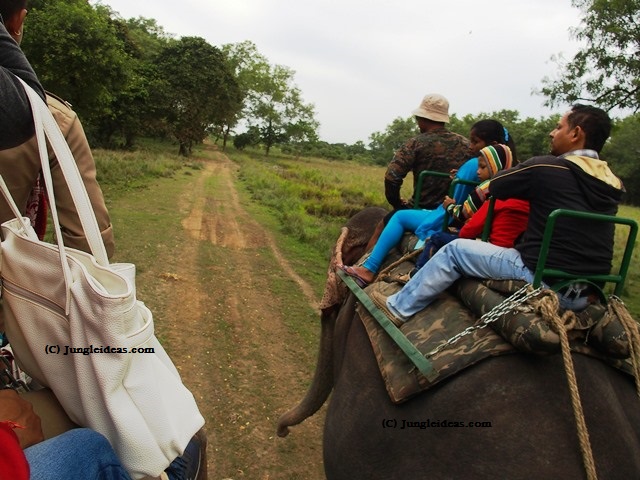
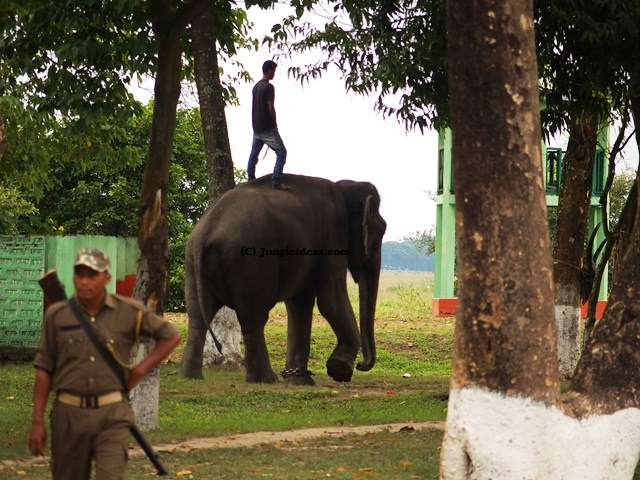
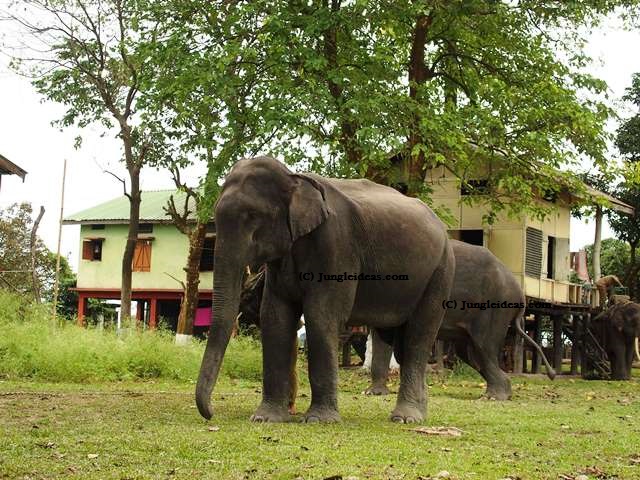

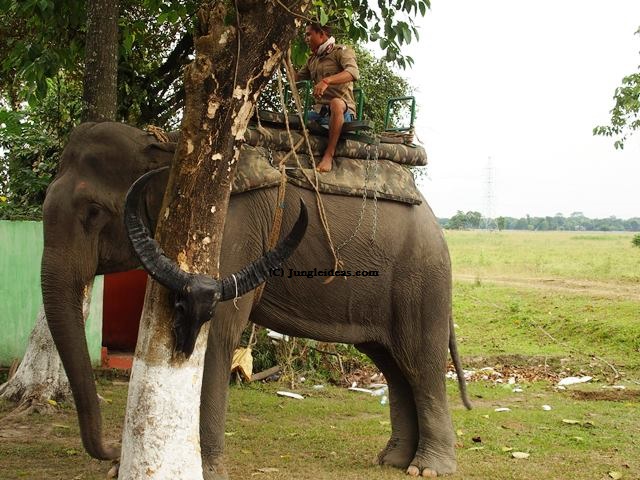
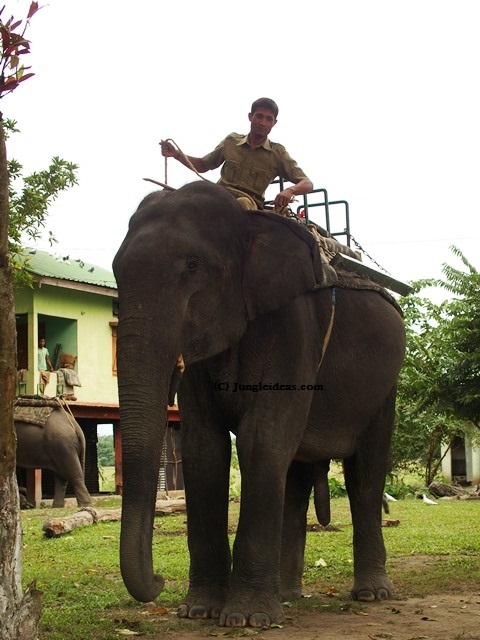
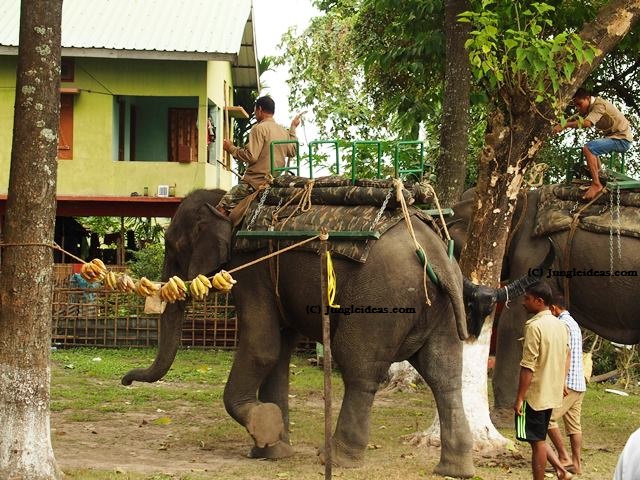
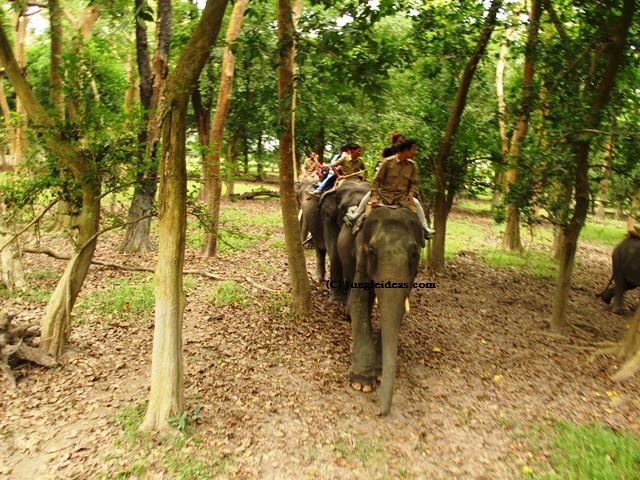






Latest News Manas National Park ~
Manas National Park reopens for tourists for season 2019 – 20
Date: Oct 4, 2019: Source ~ Times of India
Manas National Park, the 2nd UNESCO World Heritage Site of Assam has been reopened to tourists for the season 2019 – 20 after battling several months of the severe monsoons of Assam. Manas National Park was reopened by Deputy Chief of Bodoland Territorial Council (BTC) Kampa Bergoyang is an official function in the presence of a large no of officials and visitors at the Bansbari forest range of Manas in Baksa district of Assam. The park is scheduled to organize both Elephant and Jeep Safari into the interiors. During the inauguration the BTC deputy chief also said that the forest and tourist departments of BTC are working for sufficient development inside the park to enhance the natural beauty of the place and make Manas National Park a World renowned tourism destination.
At Manas National Park, street play organized to highlight the importance of water by school children
Date: Oct 10, 2019: Source ~ nenow.in
A street play highlighting the importance of water conservation at Manas National Park was organized by students of the Bahbari High School in Baksa district. Some 32 students took this opportunity to take part in the play that was staged during the reopening of the Manas National Park for tourist season 2019-20 and the play was conceived by local artist JP Das and Wildlife Trust of India’s head veterinarian Dr. Bhaskar Choudhury. The play highlighted how tha Manas National Park and Tiger Reserve that supports 22 streams and rivers have enhanced wildlife and people living by the banks. The play also highlighted the harms of use of single use plastic in Manas National Park as well. Appreciated by everyone the student later went on Jeep Safari ride into the interiors of Manas National Park.
Verdict to boost conservation of wildlife at Manas National Park
Date: June 24, 2019: Source ~ The Telegraph
A sessions court at Bijini in lower Assam had released a verdict that will come as a boon to steps for effective wildlife conservation at Manas National Park in Assam. As per the verdict record, five convicts were sentenced to seven years of rigorous imprisonment and fined INR 50,000 for three offences committed inside the forest reserves of Manas National Park that included poaching of a deer, use of firearms for poaching and killing of wild animals and birds. As per the forest officials this strong conviction will surely give a boost to effective conservation as earlier the poor convictions did not instill fear in the minds of poachers and they had the audacity to return and commit more of wildlife crime with acts related to poaching. Now with the verdict they would be scared enough and think twice before entering the forest reserves of Manas National Park to carry out any poaching related activities for the better good of wildlife.
Rhinos raised in Kaziranga National Park find home at Manas National Park
Date: Jan 2019: Source ~ The Hindu
Huge quantities of arms and explosives seized from Manas National Park
Sep 24, 2019: Source ~ Hindustan Times
In an operation carried out by special security forces, a huge load of ammunition and explosives were seized from inside the Manas National Park at the border of India and Bhutan and as per reports it is believed that these belonged to the banned NDFB militant outfit. The arms seized in a joint operation by Assam Police, Indian Army and SSB that started at 5 PM on monday and continued upto tuesday in the Panbari reserve forest area of Manas National Park. Eight packets wrapped in plastic was recovered by sniffer dogs that had factory made rifles, country made rifles, plastic explosives, sniper rifles, pistol, etc.
Manas National Park is one of the best wildlife destinations in the country and being a second World Heritage site and this is sure to leave you with thrilling adventure. Manas National Park is a best place for travellers who come to experience wildlife at its best. Manas National Park is not very crowded when compared to Kaziranga National Park in Assam and this is the place that is a place known for the varied species of animals that are rare and endangered like the Pygmy Hog, Golden Langurs, Bengal Tigers, Clouded Leopard, etc. and the famous One Horned Rhinoceros of Assam. Manas National Park is a natural gem that is a perfect getaway for wanderlusts. The beauty of the park is very comprehensive and it is a perfect place to bird lovers who come from all around the World to witness the rare birds of the likes of the Bengal Florican, Great Indian Hornbill, etc. Manas National Park is located at the foothills of the Eastern Himalayas and it is located at the India-Bhutan border and the park is contiguous with the Royal Manas National Park in Bhutan. Manas National Park in Assam is a renowned Tiger Reserve and Elephant Reserve and guests from all over the World come to witness the beauty and landscape of this UNESCO World Heritage Site.
At Manas, there are two modes of jungle safari rides viz. the Elephant Safari and the Jeep Safari rides that allow guests to explore across the forest reserves of the Manas National Park. Elephant Safari rides inside the forest reserves of Manas National Park are conducted in the early mornings while the jeep safari rides are conducted in the morning as well as the afternoon time. Apart from these two safari rides, guests at Manas National Park can also enjoy river rafting that is conducted on the River Manas that flows alongside the area of the Manas National Park. It is best advised to carry binoculars and your digital cameras to have the best wildlife viewing experience in the forest reserves of Manas National Park. Apart from the safari rides here, guests can get to enjoy bird watching, tribal village tour of the Bodo people of Manas and visit the vast tea plantations around Manas National Park. Manas National Park remains open to guests for wildlife safari from the months of October to June an you can plan your visit in the winter season when the park is filled with all the migratory birds and the animals are also visible clearly as well. Manas National Park has a tropical climate and so in the winters you are advised to carry warm clothes and also it is advisable to you to never get down from your jeep safari rides in the middle as it is against the law and always listen to your guides as they are the best judge for the guests to look out for the animals here at Manas National Park.
Manas National Park in Assam is a prized UNESCO World Heritage Site that is known to attract visitors from all across the World who come to Manas National Park to spot the varied wildlife and birds of the place and also get to witness the life and traditions of the indigenous Bodo people of Assam. Manas National Park is located at the Chirang, Baksa, Darrang and Kokrajhar district of Assam and there are three preferred safari zones at the park namely Bansbari (Central), Panbari (Western) and Bhuyanpara (Eastern Zone). Guests coming to Manas National Park can undertake their jeep safari rides across all the three zones and the vast biodiversity of the park is a very interesting thing to witness. The Bansbari central zone is the most important safari area of the Manas National Park and this is the zone that where the animals are known to be spotted reportedly that include the Asian Elephants, One Horned Rhinoceros, Leopards, Barking Deer, Hoolock Gibbons, etc. The Bhuyanpara safari zone at Manas National Park is also known as the place that allows diverse spotting of animals and birds and this zone is filled with the safari options at Manas National Park and guests can get to experience the various bird species here. The Panbari zone at Manas National Park is also known for grand sightings and guests who go for safari at this zone can get to witness the various wild beasts and the rare birds of Manas National Park. Manas National Park in Assam is known to attract visitors from all across the World who come to Manas National Park to spot the varied wildlife and birds of the place and also get to witness the life and traditions of the Bodo people of Assam.
Manas National Park is known as the place that attracts several thousand guests to the park every year and located at the foothills of the Eastern Himalayas, this park is known to be one of the most pristine wildlife habitat of Assam. The Manas National Park is known to impress tourists from worldwide and the various animals found here are the Bengal Tigers, wild buffalo, pygmy hog, hispid hare, capped langurs, golden langurs, Rhinoceros, Hog Deers, Asian Elephants, etc. The Bansari zone of Manas National Park is known to be a very picturesque retreat that is recommended to all tourists by the local guides of Manas. This Bansbari zone is located right at the entrance of Manas National Park and this is a perfect offbeat destination to explore. Bansbari zone is at the central zone of Manas National Park near the Barpeta road and this zone is having green pastures and water holes and rivers. The chances of spotting the rhinos, Tigers, wild water buffaloes is ideal here at the Bansari zone of Manas National Park. At Bansbari, there are several accommodations for your stay at Manas National Park and you can get to enjoy a nice luxury stay at the MUSA jungle retreat here. At the outskirts of the Bansbari range you can get to enjoy nature walks and this allows you to enjoy birdwatching across the tall trees. To enter the Bansbari range at Manas National Park you will need to have the safari permits and vehicles and our local executives at Manas National Park will arrange for your requisites to visit Bansbari in Manas.
Another popular safari zone at Manas National Park is the eastern range or the Bhuyanpara zone that is known to be the main grassland area of Manas National Park. This Bhuyanpara zone in Manas National Park is considered to be one of the best zones for tiger sighting at the park and the prominent area where the Bengal Tigers are known to be spotted is that of the Mali Bana area. The region is very rich in biodiversity and apart from the Bengal Tigers of Manas National Park, one can get the opportunity to sight the Assam Roofed Turtle, Hispid Hare, Golden Langur, Swamp Deer, One Horned Rhinoceros, the Pygmy Hog and also the Bengal Florican bird species. The Manas National Park being a UNESCO World heritage Site and a Tiger reserve and elephant reserve so it is advised that you do not enter the premises of the park without the services of a local guide who are known to be the best judge of the forests as they have lived across the place since their early years and they know a lot about the interiors of the park. To enter the Bhuyanpara zone at Manas National Park, you have to possess the requisite permits and safari vehicles and this can be arranged smoothly by our associate who have been conducting safari visits inside Manas National Park since many years and they are the perfect local guides to guide you on your safari as well.
The Panbari zone is another of the safari zones in Manas National Park and this too is blessed with a vast biodiversity landscape and the intense forests of the Panbari zone makes it an ideal spot for the sighting of the animals of Manas National Park. The Panbari zone at Manas National Park is a hotspot for the picnic goers and this is located at the western region of the park. The Panbari zone is located at a distance of 35km from the Barpeta road and also 150km from the city of Guwahati in Assam. The Panbari zone at Manas National Park is known as an ideal place to chill out for the guests and there are many local villages at the proximity of the park. The Panbari zone is a place where one can get to find many lodges and guest houses for a good night’s stay and the services of a guide is mandatory to explore inside the park area. The Panbari zone offers its guests one of the best wildlife viewing experiences and the species of birds and animals across the place is vast. For your safari booking at the Panbari area of Manas National Park you can reach out to us and we will offer you one of the best safari package to explore this zone that will be aligned with the experienced local guides who have been conducting safari tours since many years and they know the nook and corner of the zone as well.
Manas National Park is a perfect getaway for tourists who come here not only to view the wildlife of the park but also here are a host of activities to be enjoyed by tourists on their visit here. A trip to Manas National Park with your family and friends is an ideal way to spend time and enjoy the vast floral and biodiversity of the place. Apart from the jungle safari rides inside the forest reserves of Manas National Park guests can get to enjoy nature walks, rafting, cycling, trekking and various other adventure activities inside the forests of Manas National Pak as well. The wildlife safari is known to be one of the most sought after activities here at Manas National Park and guests from all over the World can come here to spot the various animals and birds of Manas National park. The various adventure sports to be enjoyed at Manas National Park are trekking and camping, where you get to explore the vast wilderness of Manas National Park and get to sight the various animals of the place as well. The elephant safari rides at Manas National Park is a very thrilling adventure to enjoy as well and these rides inside the forests are conducted in the early morning hours. The river rafting is another of the grand adventure activities to be enjoyed at Manas National Park and one can get to spot the various animals of the park and the birds as well. Manas National Park is a perfect bird watching destination for guests and the various bird species to be spotted are the great Indian Hornbills, Bengal Florican, Red headed Tragopan, Marsh Babbler, etc.
Manas National Park is located towards the west of the busy city of Guwahati and the park is spread across an area of 2837 sq. km. This place is known to be filled with biodiversity and is displays to its guests a vast array of wild animals and birds that are rare and endemic to the region. You can explore across the place to witness the beautiful forest reserves, the World class stay and accommodation options and the vast forests of the Manas National Park area. Manas National Park is inhabited by the indigenous Bodo tribes of Assam who have lived across the areas since times immemorial and it was a time when the Manas National Park area was declared as a World Heritage Site in danger as the illegal activities by the had hampered the biodiversity of the park and it was from the early 2000s that the local people decided that terrorism was not a solution to their problems and instead they took up tourism as a means to revive the area of Manas National Park and since then it has come a long way and today Manas National Park is counted as one of the best wildlife destinations in the country. Manas National Park is known as the park that is having an vibrant and unique destination for birds, deers, Bengal Tigers, leopards, One Horned Rhino, Elephants, Gaurs and also 20 species of the highly endangered species as well.
Apart from the jungle safari rides that are a unique way to explore the forest reserves of Manas National Park, there are various other activities that guests can enjoy on their visit to the Manas National Park. Manas National Park is a Tiger Reserve as well as an elephant reserve apart from being a UNESCO World Heritage Site and so you can be rest assured to spot some of the most varied wildlife across the place. The tiger sighting and elephant sightings along with the One Horned Rhinoceros is a common sight across Manas National Park and guests who come here can be rest assured to have a grand wildlife sighting experience for sure. Also you must ensure to explore the vast tea garden plantations across Manas National Park that surround the Bansbari area of the place and this is surely a candid retreat for all the nature lovers and visitors who come to Manas National Park. The tea gardens are located right at the entrance of the Manas National Park and in case you are interested to explore the tea garden factory, then you must have the opportunity to stay at the Birina Eco Camp at Manas National Park that is a heritage tea garden bungalow that has been converted to an eco camp and this allows guests a perfect stay opportunity to stay in a tea garden bungalow and also get to visit a tea factory as well.
A visit to Manas National Park in Assam is one of the most rewarding experiences for any nature and wildlife lover and the jungle safari experience at Manas National Park is a once in a lifetime opportunity. Before you go for your safari rides inside the forest reserves of Manas National Park you will be need to be prepared for certain dos and donts before entering the forest reserves here and these are must to abide rules and regulations not just for entry into Manas National Park but across any of the National Parks and the Wildlife Sanctuaries of the country as well. Please be advised that you need to have all the requisite permits before you enter the forest reserves of Manas National Park. Avail the services of local guides to enhance your sighting experiences and on your safari ride inside the forest reserves of Manas National Park, avoid wearing bright coloured clothes. The vehicle speed limit inside the park interiors will be not more than 20km/hr and on your ride allow the animals to have sufficient space and distance from the vehicle. Do not make any noise or play loud music inside the forest interiors of Manas National Park and also do not carry any eatables inside the park. Do not offer anything to the animals to eat as Manas National Park is a biodiversity reserve and so the animals have plenty of natural things to eat around the park. Ensure to pay all attention to the your jeep safari drivers and the local guides when venturing inside the park.
It is always better to consider to have your accommodation nearby the park area and this allows you to explore the vast wilderness of the forest reserves of Manas National Park on your visit here. Ensure that you report an hour early at the safari point as this allows you to have ample time to collect your permits and go for safari inside the park interiors of Manas National Park. Avoid to play loud music and do not ask the safari driver to honk the horn when you are inside the park. A strict no is to step down from the vehicle inside the forest reserves of Manas National Park unless advised by your driver or guide as this is a criminal offence punishable by law. Strict no to smoking and drinking alcohol while you are inside the forest reserves of Manas National Park. Please do not tease the animals inside the forests of Manas National Park as this will alarm them and they might come chasing your safari vehicles. Please do not create any ruckus inside the park and do not throw garbage as this is an animal territory and animal do not like to see thrash around them. Do not get excited and get to burst any kind of crackers or flammable materials inside the park as this will cause great danger inside the forest reserves especially in the dry winter season. Enjoy the thrill of safari inside the forest reserves of Manas National Park and get the opportunity to sight some rare species of animals and birds at the park.




































































